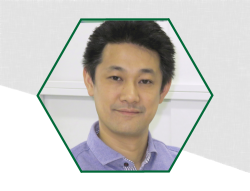Superimposed multiple shots of low-fluence femtosecond (fs) laser pulses form a periodic nanostructure on solid surfaces through ablation. The structure size observed is 1/10â1/5 of the laser wavelength, indicating the possible formation of nanoscale structures beyond the diffraction limit of light. This phenomenon has attracted considerable interest since the first observations eighteen years ago because the self-organized surface nanostructure suggests a potential route to transcend the diffraction limit in the laser-matter interactions. For fabricating a well-defined periodic nanostructure or nanograting, one of the most critical subjects has been to understand and control the interaction processes for nanostructuring at the surface.
Prof. Dr. K. Miyazaki and Dr. G. Miyaji have demonstrated that the self-organization process of nanostructuring can be regulated to fabricate a homogeneous nanograting on the target surface in air. A simple two-step ablation process was developed to control plasmonic near-fields generated by fs pulses. The results have shown the nature of a single spatial standing wave mode of surface plasmon polaritons of which periodically enhanced near-fields ablate the target surface, to form the nanograting with 200-nm or 50-nm period on GaN, using 800-nm or 266-nm fs pulses, respectively.
The presentation will also include some of the key results on the formation of nanograting on GaN, Stainless steel, Ti, and glass, and the observation of surface plasmon polariton excited on non-metallic materials with the intense fs laser pulses.
Keywords
- Femtosecond Laser Ablation
- Lipss
- Nanostructure
- Surface Plasmon Polariton

